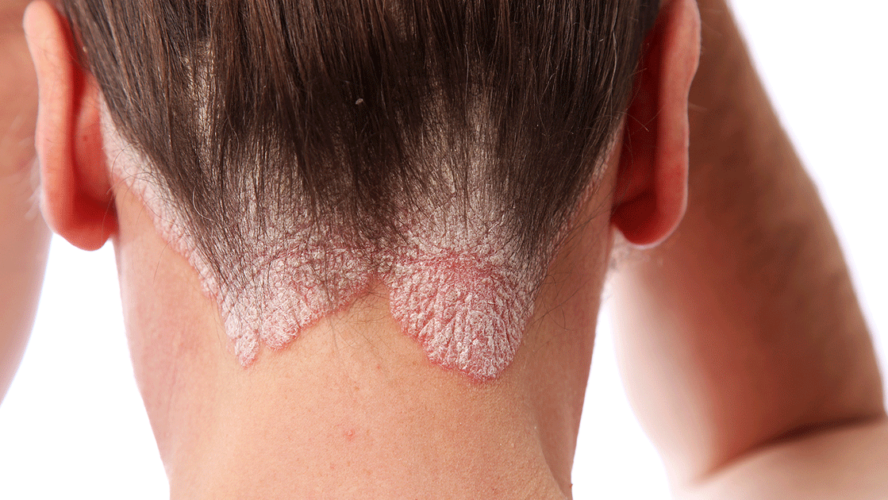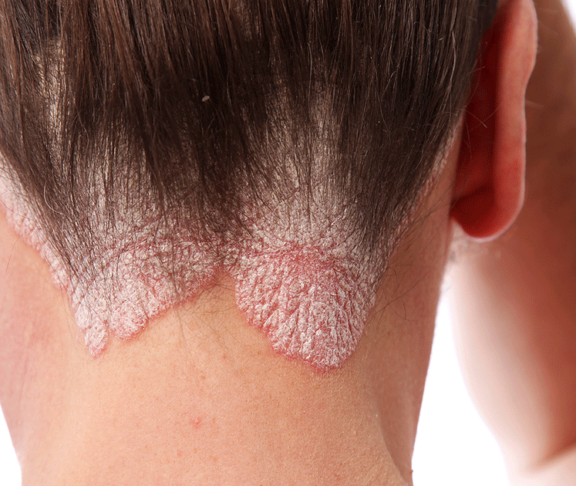Understanding the different types of psoriasis, common triggers, and the available treatment options can help patients with the condition find relief.
Psoriasis is a common chronic inflammatory skin condition that affects approximately one million Canadians and 125 million people worldwide. It’s usually characterized by elevated red patches and flaking silvery scales on the skin.
Psoriasis has a genetic basis and about one third of people with psoriasis have at least one family member with the disease. While the exact cause of psoriasis hasn’t yet been determined, researchers believe it involves a combination of genetic, environmental, and immune factors. Psoriasis develops when there’s a malfunctioning of the immune system that causes inflammation. White blood cells (T cells) in the immune system are triggered and this causes inflammation to occur, which then causes skin cells to rise to the surface and shed at 10 times the normal rate.
While psoriasis can develop at any age, it’s most typically seen in adults and occurs equally among men and women.
Understanding the signs and symptoms
Psoriasis speeds up the production of skin cells, which results in itchy and sometimes painful lesions. These patches are well-defined, red, and elevated, often with flaking silvery scales. Affected areas look dry, cracked, and inflamed. While lesions can appear anywhere on the body, the most common sites are the elbows, knees, scalp, chest, and lower back.
Psoriasis can take on a variety of forms, which include plaque, guttate, pustular, inverse, and erythrodermic. Some of these types may evolve from plaque psoriasis.
Plaque psoriasis is the most common form, and it occurs in about 90 per cent of patients. It usually begins with red scaly patches. The symptoms can range from mild to severe, covering very small or extensive areas of the body.
Guttate psoriasis is typically of abrupt onset, appearing in a few weeks and often being quite extensive. It’s marked by lesions that are small and “drop-like,” which often appear on the lower back, arms, legs, or scalp. Guttate psoriasis makes up about 10 per cent of psoriasis cases and is the second most common form.
Pustular psoriasis is characterized by pustules (pus-filled bumps) and can sometimes be disabling and life-threatening. It can be limited to certain areas of the body (localized) or widespread (generalized).
Inverse psoriasis occurs in skin folds (also called “flexures”) where there tends to be pressure, friction, or moisture or perspiration, such as between the buttocks, the genitals, under the breasts, and the armpits. These lesions are smooth and red as opposed to raised and scaling.
Erythrodermic psoriasis is a rare but serious form of the disease marked primarily by widespread redness and inflammation that resembles sunburn. It can result from severe sunburn, using certain medications (such as oral corticosteroids and lithium), or suddenly stopping psoriasis treatment.
In addition to its obvious effects on the skin, psoriasis can also affect other body tissues. Some patients with psoriasis can develop a kind of arthritis called psoriatic arthritis. This may be considered a disease in its own right, may be severe, and involves inflammation, stiffness, and pain within the joints (arthritis) in addition to skin plaques.
Knowing the triggers and treatment options
Psoriasis may be permanent or episodic, meaning that it can flare up then subside and disappear altogether for a while before another episode occurs.
Triggers or precipitating factors may cause a flare-up in disease or even lead to the development of psoriasis. These factors include increased stress, infection, injury to the skin, smoking or heavy drinking, and certain medications. Depending on the patient, an episode of psoriasis often subsides within a few weeks or months.
There are a variety of treatment options available to patients with psoriasis. These vary based on the level of severity, how large the lesions are, and patient preferences. For mild to moderate cases, creams or ointments, such as corticosteroids, vitamin D or vitamin A derivatives, or coal tar may be helpful. When the affected area is large and it’s not practical to apply creams or creams haven’t been effective, light therapy, oral medications, or injections may be recommended.
Your certified dermatologist is a leader in skin health. To learn more about psoriasis and treatment options, visit dermatology.ca.



